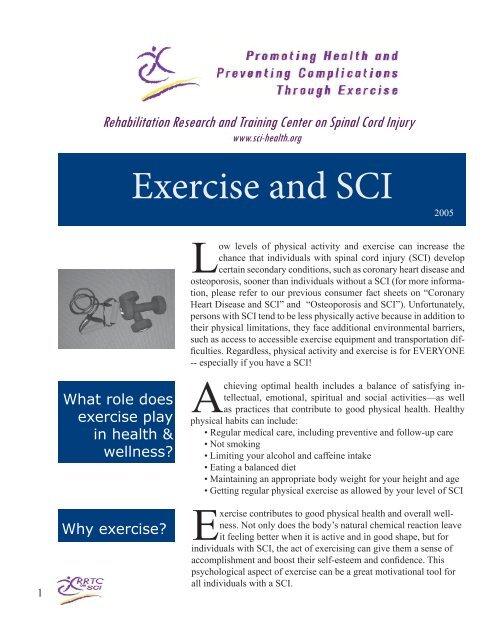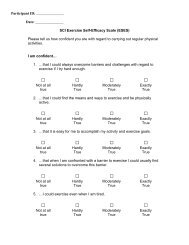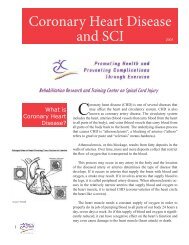Exercise and SCI - Rehabilitation Research and Training Center on ...
Exercise and SCI - Rehabilitation Research and Training Center on ...
Exercise and SCI - Rehabilitation Research and Training Center on ...
Create successful ePaper yourself
Turn your PDF publications into a flip-book with our unique Google optimized e-Paper software.
<str<strong>on</strong>g>Rehabilitati<strong>on</strong></str<strong>on</strong>g> <str<strong>on</strong>g>Research</str<strong>on</strong>g> <str<strong>on</strong>g>and</str<strong>on</strong>g> <str<strong>on</strong>g>Training</str<strong>on</strong>g> <str<strong>on</strong>g>Center</str<strong>on</strong>g> <strong>on</strong> Spinal Cord Injury<br />
www.sci-health.org<br />
<str<strong>on</strong>g>Exercise</str<strong>on</strong>g> <str<strong>on</strong>g>and</str<strong>on</strong>g> <str<strong>on</strong>g>SCI</str<strong>on</strong>g><br />
2005<br />
Low levels of physical activity <str<strong>on</strong>g>and</str<strong>on</strong>g> exercise can increase the<br />
chance that individuals with spinal cord injury (<str<strong>on</strong>g>SCI</str<strong>on</strong>g>) develop<br />
certain sec<strong>on</strong>dary c<strong>on</strong>diti<strong>on</strong>s, such as cor<strong>on</strong>ary heart disease <str<strong>on</strong>g>and</str<strong>on</strong>g><br />
osteoporosis, so<strong>on</strong>er than individuals without a <str<strong>on</strong>g>SCI</str<strong>on</strong>g> (for more informati<strong>on</strong>,<br />
please refer to our previous c<strong>on</strong>sumer fact sheets <strong>on</strong> “Cor<strong>on</strong>ary<br />
Heart Disease <str<strong>on</strong>g>and</str<strong>on</strong>g> <str<strong>on</strong>g>SCI</str<strong>on</strong>g>” <str<strong>on</strong>g>and</str<strong>on</strong>g> “Osteoporosis <str<strong>on</strong>g>and</str<strong>on</strong>g> <str<strong>on</strong>g>SCI</str<strong>on</strong>g>”). Unfortunately,<br />
pers<strong>on</strong>s with <str<strong>on</strong>g>SCI</str<strong>on</strong>g> tend to be less physically active because in additi<strong>on</strong> to<br />
their physical limitati<strong>on</strong>s, they face additi<strong>on</strong>al envir<strong>on</strong>mental barriers,<br />
such as access to accessible exercise equipment <str<strong>on</strong>g>and</str<strong>on</strong>g> transportati<strong>on</strong> difficulties.<br />
Regardless, physical activity <str<strong>on</strong>g>and</str<strong>on</strong>g> exercise is for EVERYONE<br />
-- especially if you have a <str<strong>on</strong>g>SCI</str<strong>on</strong>g>!<br />
1<br />
What role does<br />
exercise play<br />
in health &<br />
wellness<br />
Why exercise<br />
Achieving optimal health includes a balance of satisfying intellectual,<br />
emoti<strong>on</strong>al, spiritual <str<strong>on</strong>g>and</str<strong>on</strong>g> social activities—as well<br />
as practices that c<strong>on</strong>tribute to good physical health. Healthy<br />
physical habits can include:<br />
• Regular medical care, including preventive <str<strong>on</strong>g>and</str<strong>on</strong>g> follow-up care<br />
• Not smoking<br />
• Limiting your alcohol <str<strong>on</strong>g>and</str<strong>on</strong>g> caffeine intake<br />
• Eating a balanced diet<br />
• Maintaining an appropriate body weight for your height <str<strong>on</strong>g>and</str<strong>on</strong>g> age<br />
• Getting regular physical exercise as allowed by your level of <str<strong>on</strong>g>SCI</str<strong>on</strong>g><br />
<str<strong>on</strong>g>Exercise</str<strong>on</strong>g> c<strong>on</strong>tributes to good physical health <str<strong>on</strong>g>and</str<strong>on</strong>g> overall wellness.<br />
Not <strong>on</strong>ly does the body’s natural chemical reacti<strong>on</strong> leave<br />
it feeling better when it is active <str<strong>on</strong>g>and</str<strong>on</strong>g> in good shape, but for<br />
individuals with <str<strong>on</strong>g>SCI</str<strong>on</strong>g>, the act of exercising can give them a sense of<br />
accomplishment <str<strong>on</strong>g>and</str<strong>on</strong>g> boost their self-esteem <str<strong>on</strong>g>and</str<strong>on</strong>g> c<strong>on</strong>fidence. This<br />
psychological aspect of exercise can be a great motivati<strong>on</strong>al tool for<br />
all individuals with a <str<strong>on</strong>g>SCI</str<strong>on</strong>g>.
In additi<strong>on</strong>, exercise can result in:<br />
• Improved heart <str<strong>on</strong>g>and</str<strong>on</strong>g> lung functi<strong>on</strong><br />
• Lower levels of cholesterol <str<strong>on</strong>g>and</str<strong>on</strong>g> blood pressure<br />
• Increased muscular strength, flexibility <str<strong>on</strong>g>and</str<strong>on</strong>g> overall endurance<br />
• Better weight c<strong>on</strong>trol<br />
• Less anxiety <str<strong>on</strong>g>and</str<strong>on</strong>g> depressi<strong>on</strong><br />
• Enhanced feeling of well-being<br />
• Protecti<strong>on</strong> against chr<strong>on</strong>ic diseases<br />
• Improved ability to perform activities of daily living<br />
Pers<strong>on</strong>s with <str<strong>on</strong>g>SCI</str<strong>on</strong>g> who exercise or are physically active may also<br />
develop fewer sec<strong>on</strong>dary c<strong>on</strong>diti<strong>on</strong>s, including cor<strong>on</strong>ary heart disease,<br />
respiratory disease, diabetes, osteoporosis, overuse injuries, muscular<br />
imbalance, <str<strong>on</strong>g>and</str<strong>on</strong>g> pressure sores.<br />
The A, B, C’s<br />
of exercise<br />
To achieve the health benefits of physical activity <str<strong>on</strong>g>and</str<strong>on</strong>g> exercise, it<br />
is recommended that adults are active for 30 minutes at least 5<br />
days/week. Either a single sessi<strong>on</strong> of at least 30 minutes of c<strong>on</strong>tinuous<br />
activity, or several shorter sessi<strong>on</strong>s during the day works well.<br />
A typical l<strong>on</strong>g exercise sessi<strong>on</strong> c<strong>on</strong>sists of a warm-up period of light<br />
activity, followed by a main activity c<strong>on</strong>sisting of cardiovascular, muscular<br />
strength or flexibility training. The sessi<strong>on</strong> ends with a short cool<br />
down period of light activity. You can vary the routine by changing your<br />
exercise sessi<strong>on</strong>’s intensity (how hard you are exercising), durati<strong>on</strong> (how<br />
l<strong>on</strong>g you are exercising) or mode (the kind of exercise you are doing).<br />
The activity can also be structured (laps around a track, h<str<strong>on</strong>g>and</str<strong>on</strong>g>-cycling,<br />
swimming, resistance training) or unstructured (gardening, household<br />
cleaning, getting to work).<br />
Make exercise <str<strong>on</strong>g>and</str<strong>on</strong>g> physical activity fun, too! Many people enjoy<br />
therapeutic recreati<strong>on</strong> activities such as basketball, tennis, cycling <str<strong>on</strong>g>and</str<strong>on</strong>g><br />
sailing (using appropriate adaptive equipment) as part of their exercise<br />
program. In additi<strong>on</strong>, there are many sports <str<strong>on</strong>g>and</str<strong>on</strong>g> leisure organizati<strong>on</strong>s<br />
that offer new <str<strong>on</strong>g>and</str<strong>on</strong>g> exciting pursuits (for example, horseback riding, skiing,<br />
<str<strong>on</strong>g>and</str<strong>on</strong>g> rugby) for individuals with disabilities, including <str<strong>on</strong>g>SCI</str<strong>on</strong>g>.<br />
For an aerobic workout, you’ve got to work the large muscles of<br />
your body hard enough to get your heart rate <str<strong>on</strong>g>and</str<strong>on</strong>g> breathing rate up.<br />
Even exercise that feels about as strenuous as going for a brisk walk<br />
did before your injury can increase your endurance <str<strong>on</strong>g>and</str<strong>on</strong>g> cardiovascular<br />
fitness now. You can try h<str<strong>on</strong>g>and</str<strong>on</strong>g>-cycles, swimming, wheelchair sports<br />
groups, fitness videos, or yoga classes.<br />
2<br />
Doing work with your muscles – moving them against resistance,<br />
weight, or a counter force – is generally how you build strength. For<br />
some people, just getting around in a wheelchair is enough of a strength<br />
exercise. However, others prefer to lift weights. Although heavier
weights result in bigger, str<strong>on</strong>ger muscles, heavier weights also increase<br />
the chance of injury. Be careful! Use a variety of exercises to<br />
work many muscles while reducing the risk of overuse—your muscles<br />
<str<strong>on</strong>g>and</str<strong>on</strong>g> joints have to last your lifetime!<br />
“Range of moti<strong>on</strong>,” or stretching exercises, can reduce pain <str<strong>on</strong>g>and</str<strong>on</strong>g><br />
stiffness, improve posture, <str<strong>on</strong>g>and</str<strong>on</strong>g> allow you to use your muscles to their<br />
maximum. Passive range of moti<strong>on</strong>, perhaps with the help of some<strong>on</strong>e<br />
else, may be needed for those muscles you can’t move. Be careful,<br />
though, since over-stretching can result in muscle <str<strong>on</strong>g>and</str<strong>on</strong>g> ligament<br />
sprains <str<strong>on</strong>g>and</str<strong>on</strong>g> tears – or even in broken b<strong>on</strong>es!<br />
When Exercising…<br />
• Empty your bowel <str<strong>on</strong>g>and</str<strong>on</strong>g> bladder prior to exercise<br />
• Stretch your spastic muscle groups prior to exercise <str<strong>on</strong>g>and</str<strong>on</strong>g> avoid<br />
exercises that cause excessive spasticity<br />
• Drink fluids often to prevent unsafe changes in blood pressure or<br />
body temperature, <str<strong>on</strong>g>and</str<strong>on</strong>g> to prevent dehydrati<strong>on</strong><br />
• Stop exercising if you notice severe joint pain<br />
• Obtain medical help right away if you develop severe chest pain<br />
or headache, flushing, nausea or cramping<br />
• Remember to do pressure release<br />
What<br />
role does my<br />
<str<strong>on</strong>g>SCI</str<strong>on</strong>g> play<br />
Although a <str<strong>on</strong>g>SCI</str<strong>on</strong>g> can make physical activity <str<strong>on</strong>g>and</str<strong>on</strong>g> exercise harder,<br />
it certainly does not make it impossible! Since the degree of<br />
functi<strong>on</strong>al loss due to a <str<strong>on</strong>g>SCI</str<strong>on</strong>g> injury depends <strong>on</strong> the level <str<strong>on</strong>g>and</str<strong>on</strong>g><br />
extent of the injury, every<strong>on</strong>e is affected differently. Thus, your level<br />
of injury determines the physical activities <str<strong>on</strong>g>and</str<strong>on</strong>g> exercise programs<br />
that are right for you.<br />
For example, breathing exercises can offer great health benefits for<br />
some individuals with injuries between levels C1 <str<strong>on</strong>g>and</str<strong>on</strong>g> C4. In additi<strong>on</strong><br />
to breathing <str<strong>on</strong>g>and</str<strong>on</strong>g> shoulder exercises, individuals with injuries below<br />
C4 can exercise other areas. Individuals with injuries below C5 may<br />
find it better to exercise at the gym.<br />
In general, aerobic exercise will improve your heart <str<strong>on</strong>g>and</str<strong>on</strong>g> lung<br />
functi<strong>on</strong>, whereas strength training will keep your muscles str<strong>on</strong>g, so<br />
you can perform activities of daily living. And flexibility training will<br />
improve your joint range of moti<strong>on</strong> <str<strong>on</strong>g>and</str<strong>on</strong>g> reduce spasticity.<br />
3<br />
How can I<br />
work with my<br />
doctor<br />
If you are c<strong>on</strong>sidering either starting an exercise program or changing<br />
your present <strong>on</strong>e, talk with your doctor first! Because of your<br />
<str<strong>on</strong>g>SCI</str<strong>on</strong>g>, you may first need to be screened for sec<strong>on</strong>dary c<strong>on</strong>diti<strong>on</strong>s<br />
such as cardiovascular disease <str<strong>on</strong>g>and</str<strong>on</strong>g> osteoporosis. The screening results<br />
will help your doctor, therapist or trainer design your exercise program<br />
since not all activities <str<strong>on</strong>g>and</str<strong>on</strong>g> exercises may be helpful to you.
Be sure to ask your doctor <str<strong>on</strong>g>and</str<strong>on</strong>g> therapist about the wealth of additi<strong>on</strong>al<br />
resources available to you. Many printed <str<strong>on</strong>g>and</str<strong>on</strong>g> <strong>on</strong>-line materials are out<br />
there to educate <str<strong>on</strong>g>and</str<strong>on</strong>g> inform you about interesting <str<strong>on</strong>g>and</str<strong>on</strong>g> exciting opti<strong>on</strong>s for<br />
physical activity <str<strong>on</strong>g>and</str<strong>on</strong>g> exercise with a <str<strong>on</strong>g>SCI</str<strong>on</strong>g>.<br />
Take Home<br />
Tips<br />
Remember that:<br />
• Physical activity <str<strong>on</strong>g>and</str<strong>on</strong>g> exercise is for EVERYONE – even if you have a<br />
<str<strong>on</strong>g>SCI</str<strong>on</strong>g>!<br />
• It is important to talk with your doctor BEFORE starting or changing<br />
your exercise program.<br />
• You should THANK YOURSELF for making this giant step toward a<br />
healthier you!<br />
For more informati<strong>on</strong> or alternative formats, please visit our website at www.sci-health.org or call 1-<br />
866-380-4344.<br />
Disclaimer<br />
This fact sheet <strong>on</strong>ly provides general informati<strong>on</strong>. It is solely intended for informati<strong>on</strong>al <str<strong>on</strong>g>and</str<strong>on</strong>g> educati<strong>on</strong>al purposes<br />
<str<strong>on</strong>g>and</str<strong>on</strong>g> is not intended nor implied to be the diagnosis or treatment of a medical c<strong>on</strong>diti<strong>on</strong> or a substitute for professi<strong>on</strong>al<br />
medical advice relative to your specific medical c<strong>on</strong>diti<strong>on</strong>s. Always seek the advice of your physician or other<br />
qualified health provider prior to starting any new treatment or with any questi<strong>on</strong>s you may have regarding your<br />
medical c<strong>on</strong>diti<strong>on</strong>.<br />
Funded by the US Dept. of Educati<strong>on</strong>, NIDRR,<br />
Grant #H133B031114<br />
Nati<strong>on</strong>al <str<strong>on</strong>g>Rehabilitati<strong>on</strong></str<strong>on</strong>g> Hospital<br />
<str<strong>on</strong>g>Research</str<strong>on</strong>g> Divisi<strong>on</strong><br />
102 Irving Street NW<br />
Washingt<strong>on</strong>, DC 20010-2949




